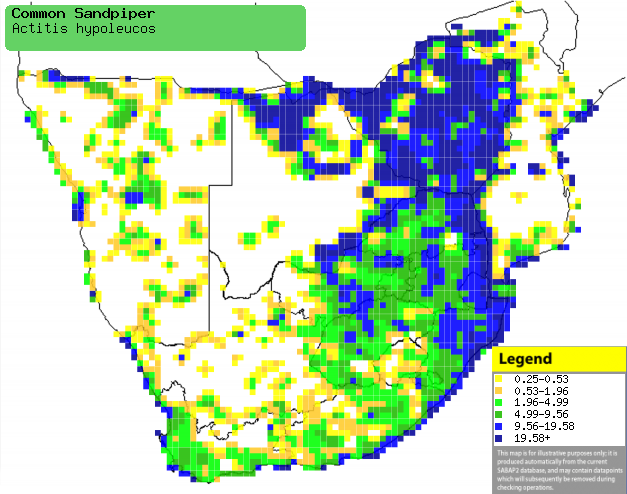|
Actitis hypoleucos (Common
sandpiper)
Gewone ruiter [Afrikaans]; Uthuthula (also applied to Wood
sandpiper) [Xhosa]; Koe-koe-lemao (generic term for sandpiper),
Seealemabopo-hetlatoeu [South Sotho]; N'wantshekutsheku (generic term for
sandpiper or plover) [Tsonga]; Oeverloper [Dutch]; Chevalier guignette [French];
Flußuferläufer [German]; Maçarico-das-rochas [Portuguese]
Life
> Eukaryotes >
Opisthokonta
> Metazoa (animals) >
Bilateria >
Deuterostomia > Chordata >
Craniata > Vertebrata (vertebrates) > Gnathostomata (jawed
vertebrates) > Teleostomi (teleost fish) > Osteichthyes (bony fish) > Class:
Sarcopterygii (lobe-finned
fish) > Stegocephalia (terrestrial
vertebrates) > Tetrapoda
(four-legged vertebrates) > Reptiliomorpha > Amniota >
Reptilia (reptiles) >
Romeriida > Diapsida > Archosauromorpha > Archosauria >
Dinosauria
(dinosaurs) > Saurischia > Theropoda (bipedal predatory dinosaurs) >
Coelurosauria > Maniraptora > Aves
(birds) >
Order: Charadriiformes > Family: Scolopacidae
Distribution and habitat
Breeds in a broad area between 30-56° North and from
western Europe to Japan, heading south in the non-breeding season to Australia
and much of sub-Saharan Africa , from southern Mauritania to Eritrea south to
southern Africa. Here it is common in northern and eastern Botswana, Zimbabwe,
central and southern Mozambique and the eastern half and the western coast of
South Africa, while more scarce in Namibia and central South Africa. It can
occupy any type of aquatic habitat, generally preferring rivers, streams, dam
shores, estuaries, tidal creeks in salt marshes, mangroves and filtration tanks
of sewage works, which it especially favours.
|
 |
|
Distribution of Common sandpiper in southern Africa,
based on statistical smoothing of the records from first SA Bird Atlas
Project (©
Animal Demography unit, University of
Cape Town; smoothing by Birgit Erni and Francesca Little). Colours range
from dark blue (most common) through to yellow (least common).
See here for the latest distribution
from the SABAP2. |
Movements and migrations
Non-breeding migrant to southern Africa, with
adults leaving Europe in late June or early July after which the
juveniles follow them in the period from July-September. The first
adults arrive in southern Africa in the second week of July and are
widespread in the region by August, while the first juveniles arrive
in late August and are common by September-October. Both adults and
juveniles usually leave in the period from late January to April,
rarely staying until May.
Food
It mainly eats invertebrates, especially insects, doing
most of its foraging by walking slowly with its head held almost horizontally,
plucking prey from the ground or low vegetation. It also gleans insects from the
backs of Nile crocodiles (Crocodylus niloticus) and Hippopotamuses (Hippopotamus
amphibius). The following food items have been recorded
in its diet:
- Invertebrates
- insects
- spiders
- crustaceans
- molluscs
- annelid worms
- Vertebrates
- small frogs and tadpoles
- small fish
- Plants
Threats
Not threatened, in fact common and globally widespread.
References
-
Hockey PAR, Dean WRJ and Ryan PG 2005. Roberts
- Birds of southern Africa, VIIth ed. The Trustees of the John Voelcker
Bird Book Fund, Cape Town.
|
